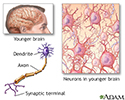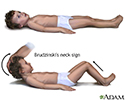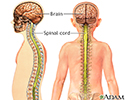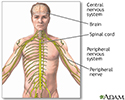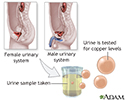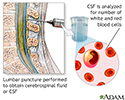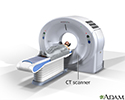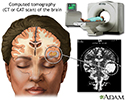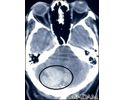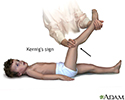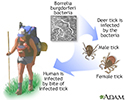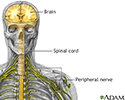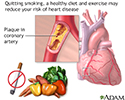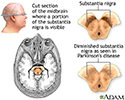Multimedia Gallery
Herniated disk
You might have heard a friend say that they have "slipped a disk." Or, you may have slipped a disk yourself during an overly strenuous workout, or by straining while lifting something heavy. A slipped disk can be painful, so painful, in fact, that you can barely move. But what exactly is a slipped disk? And what can you do about it if you have one?
This is your spine. In between the bones, which are called vertebrae, are little cushioning disks. These disks not only allow you to bend and move but also prevent your bones from rubbing against each other.
Sometimes an injury can push a disk out of place, producing a bulge. This bulge is called a herniated disk. Or, a disk may break open. When a disk moves, it puts pressure on nearby nerves, and that's when you start to feel pain. Most slipped disks are found in the lower back or lumbar region, although you can also have one in your neck, or cervical region.
When you have a slipped disk, you'll hurt, but often just on one side of your body. If the disk is in your lower back, you may feel a sharp pain in one part of your leg, hip, or buttocks. Your leg may also feel weaker than usual. If the disk is in your neck, the pain and numbness can stretch all the way from your neck down to your shoulder and arm. You may notice that it hurts even more when you stand for a long period of time, or if you sneeze, cough, or laugh.
So, how do you treat a slipped disk?
First your doctor will want to make sure that you actually have a slipped disk. To find out, the doctor will check your muscle strength, feeling, and reflexes, and have you move in different ways, for example, by bending, standing, and walking. You may also have a scan to find the exact location of the slipped disk.
While bed rest was once the standard therapy for low back pain, studies show that for most people it does not help and may even make the situation worse. Rapid return to healthy normal activity is usually best, being careful not to put too much stress on the back. While you're doing that, you can take medicines like ibuprofen or aspirin to relieve the pain. Muscle relaxants may also help. Acupuncture, massage, and yoga have also been shown to be affective in some studies. Physical therapy may be helpful after the first two or three weeks. It can help strengthen the muscles of your spine, and teach you how to move properly so you don't injure yourself again.
If these measures don't help, your doctor may suggest getting steroid injections into the area where you slipped the disk, to reduce pain and relieve swelling. As a last resort when all other treatments have failed, you may have a surgery called a diskectomy to remove the damaged disk.
You may be in pain now, but don't despair, with treatment it should ease. Realize that it may take a few months before you're back to your old self. Don't try to overdo it by bending or doing any heavy lifting. You'll just wind up back on your couch, hurting again.
Herniated disk
Review Date: 6/4/2025
Reviewed By: C. Benjamin Ma, MD, Professor, Chief, Sports Medicine and Shoulder Service, UCSF Department of Orthopaedic Surgery, San Francisco, CA. Also reviewed by David C. Dugdale, MD, Medical Director, Brenda Conaway, Editorial Director, and the A.D.A.M. Editorial team.
Animations
- Alzheimer disease
- Alzheimer disease
- Asperger syndrome
- Atherosclerosis
- Athetosis resulting from ba...
- Attention deficit hyperacti...
- Autism spectrum disorders
- Bladder function - neurolog...
- Brain components
- Cerebral aneurysm
- Cerebral palsy
- Cholesterol and triglycerid...
- Cluster headache
- Concussion
- Concussion
- Diabetes
- Epilepsy
- Epinephrine and exercise
- Erection problems
- Essential hypertension
- Feeling pain
- Hardening of arteries
- Head injury
- Herniated disk
- Herniated nucleus pulposus ...
- How to use a pill cutter
- Hypertension - overview
- Insomnia
- Migraine
- Multiple sclerosis
- Neck pain
- Nerve conduction
- Parkinson disease
- Sciatica
- Seizures
- Shingles
- Sleep disorders
- Spinal stenosis
- Stroke
- Stroke
- Stroke - secondary to cardi...
- Systemic lupus erythematosus
- Tension headache
- Understanding cholesterol r...
- Urinary incontinence
Illustrations
- 15/15 rule
- Active vs. inactive muscle
- Acupuncture
- Adult dermatome
- Alcoholic neuropathy
- Alpha-glucosidase inhibitors
- Alzheimer disease
- Amebic brain abscess
- Amyloidosis of the fingers
- Arterial plaque build-up
- Arterial tear in internal c...
- Arteries of the brain
- Atherosclerosis
- Atherosclerosis of internal...
- Autonomic Nerves
- Balance receptors
- Before and after hematoma repair
- Bicycle helmet - proper usage
- Biguanides
- Blood pressure
- Blood pressure check
- Blood test
- Blood test
- Bone graft harvest
- Brain
- Brain
- Brain and nervous system
- Brain herniation
- Brain structures
- Brain wave monitor
- Brainstem function
- Brudzinski's sign of meningitis
- Calories and fat per serving
- Carotid dissection
- Carotid duplex
- Carotid stenosis - X-ray of...
- Carotid stenosis - X-ray of...
- Carpal tunnel surgical procedure
- Carpal tunnel syndrome
- Cataract - close-up of the eye
- Cauda equina
- Cause of headaches
- Causes of secondary headache
- Central nervous system
- Central nervous system
- Central nervous system and ...
- Cerebellum - function
- Cerebral aneurysm
- Cerebral aneurysm
- Cerebrospinal fluid leak
- Cervical spondylosis
- Cervical vertebrae
- Cholesterol
- Cholesterol producers
- Circle of Willis
- Common peroneal nerve dysfu...
- Complex carbohydrates
- Compression fracture
- Compression of the median nerve
- Concussion
- Congenital toxoplasmosis
- Copper urine test
- Coronary artery blockage
- Craniotomy for cerebral shunt
- Creutzfeldt-Jakob disease
- Crossed eyes
- CSF cell count
- CSF chemistry
- CSF protein test
- CT scan
- CT scan of the brain
- Damaged axillary nerve
- DASH diet
- Developmental process of at...
- Diabetes and exercise
- Diabetes and nerve damage
- Diabetic blood circulation ...
- Diabetic emergency supplies
- Diabetic retinopathy
- Ear anatomy
- Effects of age on blood pressure
- Electromyography
- Endarterectomy
- Endocrine glands
- Enlarged view of atherosclerosis
- Exercise can lower blood pr...
- External and internal eye a...
- Eye
- Eye ultrasound
- Facial drooping
- Femoral nerve damage
- Fibromyalgia
- Fish in diet
- Food and insulin release
- Forward bend test
- Glaucoma
- Glossopharyngeal neuralgia
- Glucose in blood
- Glucose test
- Grand mal seizure
- Gray and white matter of th...
- Haemophilus influenzae organism
- Head injury
- Head trauma
- Headache
- Healthy diet
- Herniated disk repair
- Herniated lumbar disk
- Herniated nucleus pulposus
- Herpes zoster (shingles) - ...
- Herpes zoster (shingles) di...
- Herpes zoster (shingles) on...
- Herpes zoster (shingles) on...
- Herpes zoster (shingles) on...
- Herpes zoster (shingles) on...
- Herpes zoster (shingles) on...
- Herpes zoster (shingles) on...
- Herpes zoster (shingles) on...
- High blood pressure tests
- Hunger center in brain
- Hypothalamus
- Increased intracranial pressure
- Indications of head injury
- Insulin production and diabetes
- Insulin pump
- Insulin pump
- Intervertebral disk
- Intracerebellar hemorrhage ...
- Intracerebral hemorrhage
- Intracranial pressure monitoring
- Irregular sleep
- Kernig's sign of meningitis
- Kyphosis
- Late-stage syphilis
- Left cerebral hemisphere - ...
- Leukoencephalopathy
- Lifestyle changes
- Limbic system
- Lobes of the brain
- Location of whiplash pain
- Low blood sugar symptoms
- Lower leg muscles
- Lumbar puncture (spinal tap)
- Lumbar vertebrae
- Lumbar vertebrae
- Lyme disease
- Lyme disease - Borrelia bur...
- Lyme disease - erythema migrans
- Lyme disease organism - Bor...
- Meninges of the brain
- Meninges of the spine
- Migraine cause
- Migraine headache
- Monitoring blood pressure
- Motor nerves
- MRI of the brain
- MRI scans
- Multiple sclerosis
- Muscle cells vs. fat cells
- Muscle fatigue
- Muscle pain
- Muscular atrophy
- Myelin and nerve structure
- myPlate
- Neck pain
- Nerve biopsy
- Nerve conduction test
- Nerve supply to the pelvis
- Nervous system
- Neurofibromatosis I - enlar...
- Normal pupil
- Omega-3 fatty acids
- Optic nerve
- Pain of cluster headache
- Phytochemicals
- Pituitary gland
- Plaque buildup in arteries
- Prevention of heart disease
- Primary brain tumor
- Ptosis - drooping of the eyelid
- Radial nerve dysfunction
- Radiation therapy
- Retina
- Right cerebral hemisphere -...
- Role of the vagus nerve in ...
- Sacrum
- Saturated fats
- Sciatic nerve
- Sciatic nerve damage
- Scoliosis
- Scoliosis
- Scoliosis brace
- Shaken baby symptoms
- Shingles
- Signs of scoliosis
- Simple carbohydrates
- Skeletal spine
- Skull of a newborn
- Skull of an adult
- Sleep patterns in the young...
- Sleep studies
- Slit-lamp exam
- Soluble and insoluble fiber
- Spinal anatomy
- Spinal cord injury
- Spinal curves
- Spinal fusion
- Spinal stenosis
- Spinal stenosis
- Spinal tumor
- Spine supporting structures
- Stroke
- Subdural hematoma
- Subdural hematoma
- Substantia nigra and Parkin...
- Sulfonylureas drug
- Systemic lupus erythematosus
- Tension-type headache
- Thiazolidinediones
- Thoracic outlet anatomy
- Tibial nerve
- Tick - deer engorged on the skin
- Tick, deer - adult female
- Torticollis (wry neck)
- Trans fatty acids
- Transient Ischemic attack (TIA)
- Tympanic membrane
- Type I diabetes
- Ulnar nerve damage
- Ultrasound, normal fetus - ...
- Untreated hypertension
- Vascular headaches
- Ventricles of the brain
- Vertebra and spinal nerves
- Vertebra, cervical (neck)
- Vertebra, lumbar (low back)
- Vertebra, thoracic (mid back)
- Vertebrae
- Vertebral column
- Vertigo
- Visual acuity test
- Visual field test
- Vitamin B6 benefit
- Vitamin B6 source
- Voiding cystourethrogram
- Weight loss
- Whiplash
- Wrist anatomy
- X-linked recessive genetic ...
- X-linked recessive genetic ...
- X-linked recessive genetic ...
- X-ray
- Yo-yo dieting
Presentations
- Carotid artery surgery - series
- Carpal tunnel repair - series
- Craniotomy - series
- CSF oligoclonal banding - ...
- Lumbar spinal surgery - series
- Meningocele repair - series
- Microdiskectomy - series
- Monitoring blood glucose - ...
- Spinal fusion - series
- Spinal surgery - cervical -...
- Stroke - series
- Two person roll - series
- Ventriculoperitoneal shunt ...

 Bookmark
Bookmark







































































